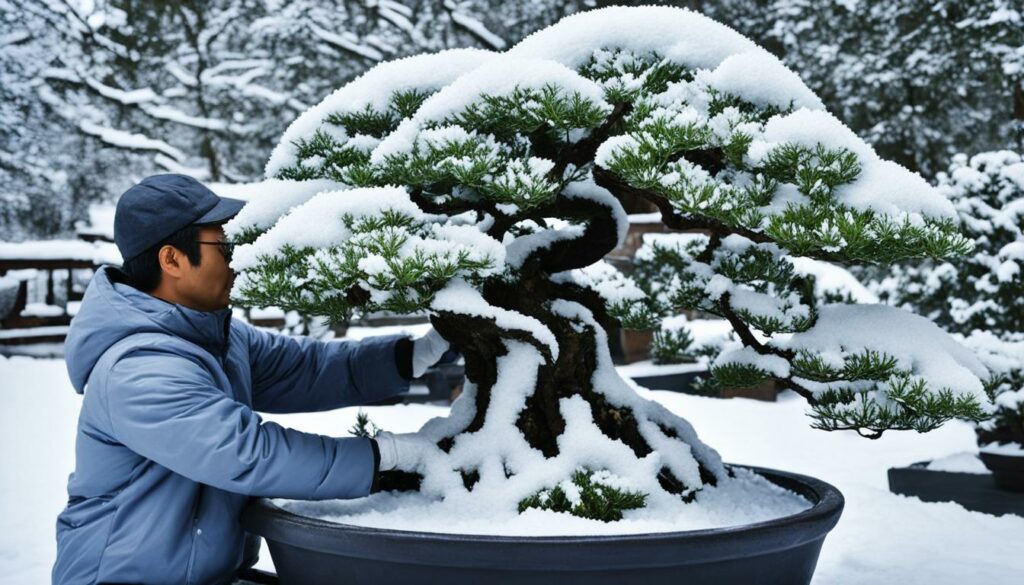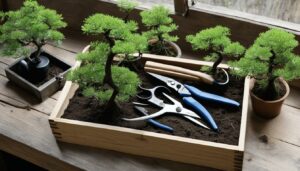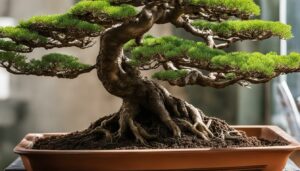As the winter season approaches, the preservation of your bonsai’s splendor involves a meticulous process of bonsai overwintering. Embracing the chill, these miniature masterpieces need your careful attention to navigate the frostbitten months. Proper winterizing bonsai techniques become essential for protection against the harsh elements. Providing cold protection and frost care will not only ensure the survival of your bonsai but also its thriving return in spring.
The key to successful overwintering lies in understanding the specific needs of your bonsai species. Some may require a cozy indoor haven, while others can endure the cold under a protective cover. Regardless, winter care is imperative for all bonsai to maintain their health and vitality during the dormant period. Get ready to equip yourself with the knowledge to keep your bonsai trees in top condition throughout the frosty weather.
Key Takeaways
- Grasp the nuances of bonsai overwintering specific to your tree species.
- Implement effective cold protection measures to prevent frostbite.
- Maintain a balance between dormancy and vitality with proper winterizing bonsai practices.
- Know when to keep bonsai indoors and when they can benefit from the winter’s cold.
- Discover the importance of regular monitoring for frost care throughout winter.
Understanding Bonsai Dormancy and Winter Needs
As the seasons change, your bonsai trees enter a phase known as bonsai dormancy, a natural cycle that is vital for their survival and future growth. During this period, your trees conserve energy, slowing down their metabolism as preparation for the spring. This rest phase is crucial as it allows your bonsai to endure the cold while minimizing stress and potential damage.
Appropriate winter care is essential in maintaining the health of your bonsai throughout this dormant phase. It involves understanding and providing the correct measures of cold protection and faithfully adhering to bonsai overwintering techniques specific to each species. Whether you’re nurturing a deciduous miniature maple or an evergreen juniper, each bonsai has unique requirements that must be met for successful overwintering.
It’s pivotal to tailor your approach depending on whether your bonsai is an indoor variety or one that traditionally lives outside. Indoor species tend to require stable temperatures and adequate lighting, while outdoor species benefit from protective measures against the harsher elements.
- Identify your bonsai species and its specific dormancy needs
- Study the typical winter climate of your region
- Establish a regimen that balances temperature, light, and moisture
Experts suggest employing methods such as mulching, using cold frames, or even relocating your bonsai to a sheltered outdoor setting can significantly assist in their preservation during colder months. Not only do these techniques offer insulation, but they also afford a buffer against the fluctuating temperatures that can be especially harmful during this sensitive stage.
Remember, the top priority in winter care for bonsai is to respect the tree’s natural dormancy period while ensuring its health is not compromised. When done correctly, you’ll be rewarded with a thriving bonsai ready to burst into life when spring arrives.
The Right Location for Bonsai Trees During Winter
As the chill of winter approaches, it’s crucial to consider where your bonsai will spend the dormant months. The correct location is vital to ensure your bonsai overwintering is successful, providing essential cold protection and prevent frost care emergencies. With each species having its specific needs, understanding the difference between indoor and outdoor overwintering and assessing the ideal winter placement are key decisions that you must carefully weigh.
Indoor Versus Outdoor Overwintering
Indoor overwintering provides your bonsai with a stable environment, away from harsh elements. However, it requires creating conditions that mimic the tree’s natural resting phase. On the other hand, outdoor overwintering can accommodate the natural cycle, but there’s a need for vigilance against extreme cold temperatures and frost damage.
Assessing the Ideal Winter Placement
Determining the ideal winter placement involves understanding the species-specific requirements of your bonsai. Some species are hardier and can withstand colder temperatures, while tropical species will likely need the warmth an indoor environment provides. The following table can aid in deciding the best overwintering solution for your bonsai.
| Bonsai Type | Outdoor Threshold Temperature | Indoor Lighting Needs | Humidity Consideration | Cold Protection Measures |
|---|---|---|---|---|
| Deciduous | Above -10°C (14°F) | Natural light by a window | Humidity tray | Insulate pot |
| Coniferous | Above -20°C (-4°F) | Not necessary if dormant | Not critical | Shelter from wind |
| Tropical | N/A (Indoor only) | Grow lights | 50-60% humidity level | Room temperature |
| Subtropical | Above 5°C (41°F) | Bright indirect light | Mist foliage regularly | Keep away from drafts |
When winterizing bonsai, consider not only temperature but also light exposure, and whether your bonsai is a deciduous, coniferous, or tropical species. It’s a delicate balance between offering a period of rest and ensuring survival through potentially damaging cold. Attention to detail during the winter can result in a thriving bonsai ready for growth in the spring.
Temperature and Humidity Control for Healthy Bonsai
As you delve into the heart of winter, winterizing bonsai requires specific attention to both temperature control and humidity regulation. The fine art of bonsailing turns towards science in these colder months as cold protection becomes paramount. Achieving the perfect balance will help your bonsai maintain its health, avoiding the dual threats of frost damage and desiccation. Here are practical ways to monitor and adjust these critical environmental conditions.
Start by understanding that different species of bonsai trees may require various temperature and humidity levels. Some trees, such as conifers, might be more cold-hardy, while tropical species need constant warmth. Therefore, it’s essential to customize your approach for cold protection for each different bonsai you cherish.
Let’s look at the ideal ranges you should aim for and how to maintain them:
- Install a thermometer and hygrometer near your bonsai to keep a constant eye on the ambient temperature and humidity.
- For tropical species, consider using a heating mat under the container to provide a reliable heat source, thus aiding in temperature control.
- Use a humidifier or place the bonsai on a tray of water with pebbles to increase ambient moisture, this way you’ll be mastering humidity regulation.
- If the indoor air is dry, occasionally mist your bonsai to prevent leaf desiccation. However, take care not to overdo it as too much moisture in the absence of light can promote mold growth.
| Condition | Temperature Range (°F) | Humidity Range (%) |
|---|---|---|
| Coniferous Bonsai | 15-50 | 50-70 |
| Deciduous Bonsai | Just above freezing to 45 | 50-70 |
| Tropical Bonsai | 55-75 | 60-80 |
| Desert Bonsai | 40-60 | 40-60 |
To prevent the adverse effects of temperature fluctuation, it’s vital to minimize exposure to drafts and direct heat sources. Insulation can be useful here, whether you choose to wrap the pot with bubble wrap or utilize a thermal blanket during particularly chilly nights. This tactful approach will ensure that your beloved bonsai make it through winter unscathed, ready to burst into spring with vigor and vitality.
Remember, the key to successful winterizing lies in diligent monitoring and prompt adjustments. By following these guidelines for temperature control and humidity regulation, you’re taking critical steps towards cold protection for your bonsai, ensuring their survival and thriving in the colder months.
Bonsai Overwintering
As the chill sets in, ensuring the survival of your bonsai through the winter months becomes a pressing task. Bonsai overwintering is critical to maintain not only the plant’s health but also its dormancy cycle. Below, we lay out a strategic approach for winter care tailored for various climates and bonsai species. Adhering to these guidelines can prevent frost damage and guarantee a seamless transition into spring.
- Identify your bonsai species: Understand whether your bonsai is a tropical, subtropical, or cold-hardy variety to address its specific winter needs.
- Assessing the environment: Consider your local climate and whether your bonsai can be left outdoors or requires an indoor shelter.
- Guarding against frost: Implement frost care techniques such as mulching or utilizing protective covers to shield delicate roots.
Step-by-Step Winterization Process:
- Prepare your bonsai for dormancy: Gradually reduce watering and cease fertilization as fall progresses to encourage a natural dormancy state.
- Choose the right location: Whether indoors or outdoors, select a spot that mirrors the bonsai’s natural habitat as closely as possible.
- Ensure proper insulation: Use bubble wrap or styrofoam to insulate pots, reducing the risk of root freezing.
- Monitor temperature and humidity: Keep a steady eye on these factors if overwintering your bonsai indoors.
- Water judiciously: Water less frequently, but do not allow the soil to dry out completely, as hydration is crucial even in dormancy.
| Species | Indoor/Outdoor | Insulation Needed | Watering Frequency |
|---|---|---|---|
| Coniferous Bonsai | Outdoor | Yes | Once every few weeks |
| Tropical Bonsai | Indoor | No | Weekly |
| Deciduous Bonsai | Outdoor/Indoor* | Yes* | Varies* |
*Deciduous bonsai care varies based on the species and local climate; some may need indoor overwintering, while others are sufficiently hardy for living outside with adequate frost care.
Approaching the cold season with preparedness in mind for bonsai overwintering is essential. Beyond following the outlined steps, remember that patience and attentiveness throughout bonsai dormancy will reward you with a healthy and thriving bonsai when warmer temperatures return. For any specific concerns regarding winter care in extreme climates, consulting a local bonsai expert is advisable.
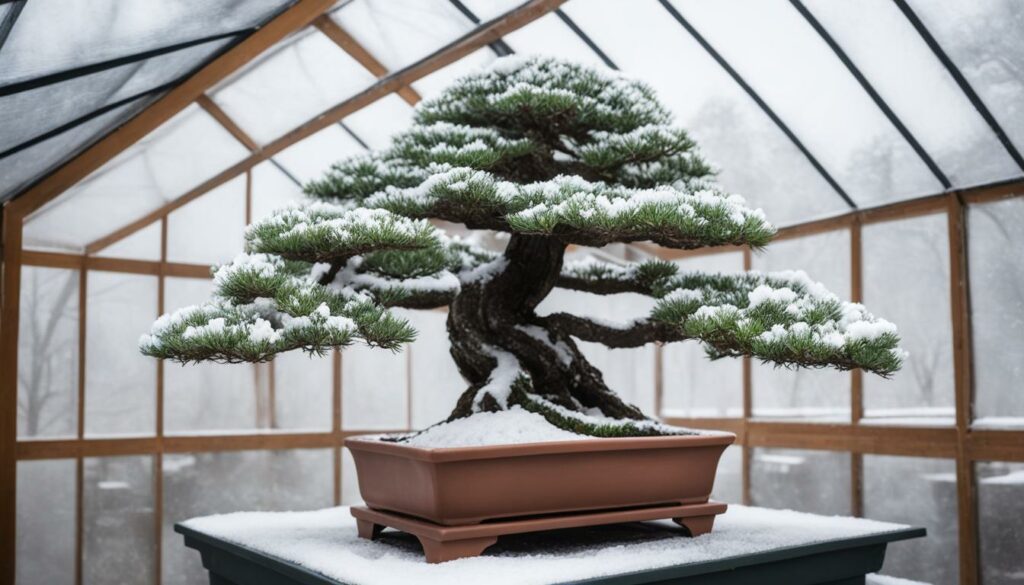
Maintaining Proper Watering Techniques in Cold Weather
As the mercury dips, the winterizing bonsai process warrants a shift in your watering routine. Unlike the growing season, winter care for bonsai involves adapting to reduced growth rates and evaporation, which makes watering bonsai a crucial but challenging task. It’s important to navigate the fine line between overwatering and underwatering to protect your cherished trees from the risks of root rot or dehydration.
To ensure your bonsai receives cold protection while being adequately hydrated, it’s essential to monitor the soil moisture regularly. Here are some actionable tips to help you master winter watering:
- Check the soil for moisture before watering – the top layer should be dry to the touch.
- Reduce watering frequency, but don’t let the roots dry out completely – balance is key.
- Water in the morning, giving time for excess water to evaporate before the temperature drops at night.
- Use lukewarm water to avoid shocking the plant’s roots with cold.
A helpful tool in maintaining proper watering is a winter watering schedule. Creating a tailored schedule for your bonsai can prevent common mistakes. The following table offers guidance on establishing a routine based on different winter conditions:
| Condition | Watering Frequency | Additional Notes |
|---|---|---|
| Mild Winter | 2-3 times per week | Monitor soil moisture regularly; conditions may fluctuate. |
| Harsh Winter | Once per week or less | Consider the use of protective structures to shield the bonsai from extreme cold. |
| Indoor Overwintering | Adjust according to indoor heating effect | Ensure proper humidity levels to prevent drying out. |
Remember, the dormant season doesn’t negate the necessity for winter care of bonsai; it merely changes the dynamics of how you approach tasks like watering.
With an understanding of these key principles for watering bonsai, you’ll be well-equipped to sustain your bonsai’s health during the winter months, setting the stage for a vibrant showcase when spring arrives.
Pruning and Care During the Winter Months
As temperatures drop and your bonsai enters dormancy, it’s crucial to adjust your care routine to support its winter needs. Winterizing bonsai isn’t just about protecting it from the cold—it’s also about understanding when and how to prune to maintain the tree’s health and structure without disrupting its natural dormancy cycle. During this period of bonsai dormancy, your approach to pruning bonsai plays a pivotal role in setting the stage for vigorous spring growth.
Seasonal pruning techniques are essential for the well-being of your bonsai. Unlike the vigorous pruning done during the growing season, winter pruning should be more conservative. Focus on removing only dead or dying branches, which can harbor pests and diseases. Also, lightly trimming back overly long branches can preserve the desired shape of your bonsai without inciting new growth prematurely.
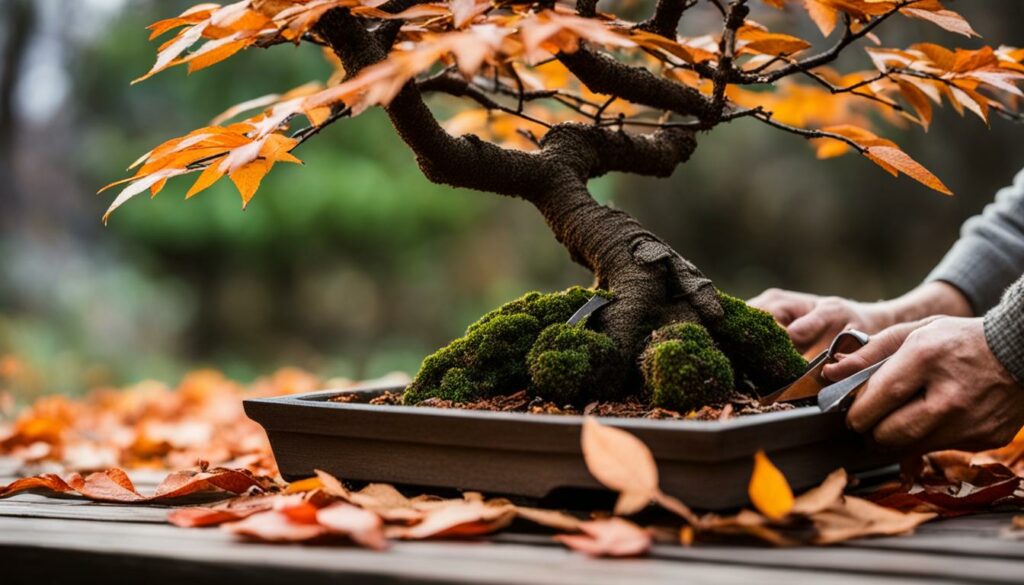
- Inspect the branches of your bonsai carefully, looking for signs that indicate which limbs need attention.
- Clean your pruning tools before and after use to prevent the spread of disease.
- Maintain a harmonious shape and avoid heavy styling that could stress the bonsai during cold months.
While pruning bonsai is certainly a focal point of winter care, it’s not the only task on your winter agenda. Monitoring for pests, managing soil moisture levels, and ensuring your bonsai has adequate protection from frost are all part of a comprehensive winter care strategy. Winter may seem like a quieter time for your bonsai, but staying vigilant during these months can prevent complications and keep your tree healthy until spring arrives.
Protecting Bonsai from Frost and Extreme Conditions
As the winter chill sets in, ensuring the safety of your bonsai becomes a primary concern. Frost care plays a crucial role in bonsai overwintering, helping to maintain the health and aesthetics of these delicate miniature trees. In addition to daily protective measures, being prepared to face extreme weather events is key to cold protection and protecting bonsai from potentially damaging conditions.
Shielding from Daily Frost
To mitigate the effects of daily frost, proactive steps must be taken. Covering the soil with mulch can serve as an insulating layer, preserving root warmth. Moreover, positioning your bonsai in an area shielded from the cold wind will minimize frostbite on the foliage and stems. When frost is forecasted, consider moving your bonsai to a more protected spot, like beneath a patio cover or inside a cold greenhouse.
Measures Against Intense Cold Waves
When an intense cold wave is predicted, rapid action is essential to protect your bonsai. For temporary emergency shelter, wrapping the pot and lower trunk in burlap or frost cloth can provide swift cold protection. Employing a frame covered with plastic sheeting around your bonsai can also create a microclimate that buffers against sudden temperature drops.
For ongoing frost care throughout cooler months, the following table suggests some strategies and materials you can utilize for effectively protecting bonsai:
| Strategy | Materials | Benefits |
|---|---|---|
| Mulching | Straw, bark chips, or pine needles | Insulates soil, retains moisture |
| Pot Wrapping | Burlap, bubble wrap, or horticultural fleece | Buffers roots from extreme cold |
| Windbreaks | Wooden boards or dense shrub planting | Reduces desiccating winds |
| Greenhouse Placement | Portable greenhouse or cold frame | Controlled environment, sunlight access |
| Emergency Shelter | Frost cloths or plastic sheeting | Quick setup for sudden frost |
While pondering over the aesthetics of your winter garden, remember that bonsai overwintering is an art that balances beauty with the necessity of plant survival. Take the time to ensure your bonsai receives the frost care and cold protection it deserves, so when spring arrives, your bonsai emerges in splendid health, ready for the warmer days ahead.
Fertilization: Is Winter the Right Time?
When the temperatures plummet and your bonsai begins its dormant phase, you might wonder about the role of fertilization. Is bolstering your bonsai with nutrients during these cold months beneficial or potentially harmful? Let’s delve into the intricacies of winterizing bonsai with a focus on fertilization practices to ensure cold protection without disrupting the natural rhythm of your bonsai’s life cycle.
During bonsai overwintering, trees are not actively growing and therefore require fewer nutrients. This is a stark contrast to the growing season when fertilization is crucial for vigorous growth. While over-fertilizing can be detrimental, leading to salt build-up in the soil and potential root damage, a measured approach to winter fertilization can be advantageous for certain trees, especially evergreens that may benefit from a mild, slow-release formula.
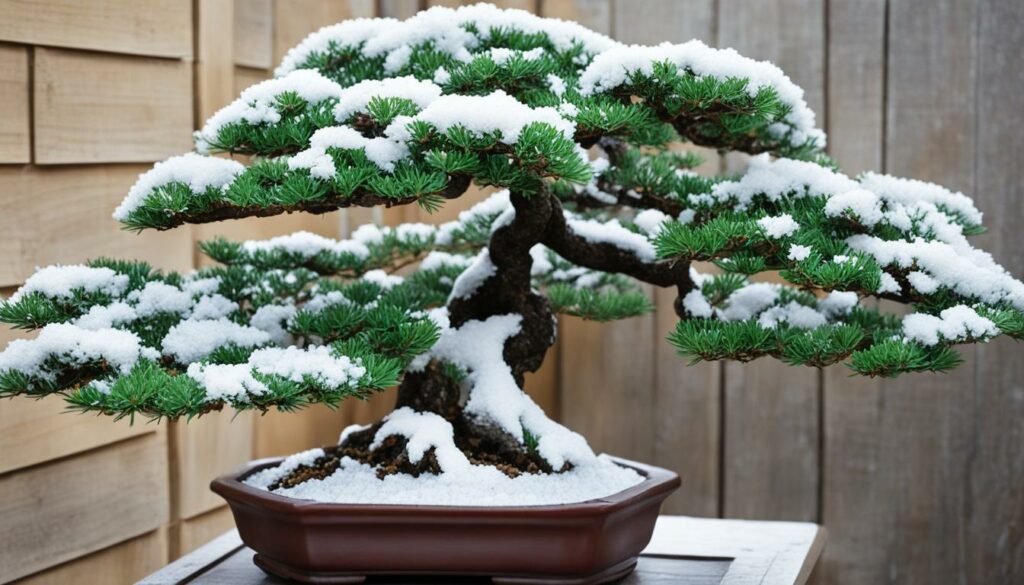
It’s imperative to recognize that the ‘one-size-fits-all’ methodology does not apply here. The choice to fertilize should be based on the species of your bonsai, the climate you’re in, and the tree’s specific health and soil needs. Conifers, for example, might appreciate a light feeding, whereas deciduous trees are best left without additional nutrients during their rest phase.
| Bonsai Type | Winter Fertilization Suggested | Type of Fertilizer | Application Timeframe |
|---|---|---|---|
| Coniferous | Yes | Slow-release, low-nitrogen | Early Winter |
| Deciduous | No | N/A | N/A |
| Evergreen | Yes | Slow-release, balanced | Early Winter |
If you decide to fertilize, it’s best to do so early in the winter before the soil freezes, and always opt for a formula with a balanced or decreased nitrogen content to prevent new growth that could be damaged by cold. Always follow labeled directions and consider the specific nutritional requirements of your bonsai to avoid overfeeding. Even in winter, your bonsai’s well-being depends on careful and knowledgeable care.
- Assess the health of your bonsai and its soil before adding any fertilizer.
- Choose the right type and amount of fertilizer for your specific bonsai species.
- Apply it at the right time—early in the dormancy period, and sparingly.
Winter care for bonsai, including fertilization, is a nuanced subject. Protecting your bonsai from the cold and ensuring it has what it needs to thrive come spring, demands consideration and knowledge. With careful overwintering strategies, including the judicious use of fertilization, your bonsai will emerge from the winter months in robust health, ready to grow and flourish.
Winter Pests and Diseases: Prevention and Treatment
As you nurture your bonsai trees through the winter, it’s crucial to address the potential threats of pests and diseases which can be detrimental during this vulnerable period. Understanding and implementing effective preventive measures, as well as recognizing symptoms of distress for timely disease treatment, are key to ensuring your bonsai’s health.
Common Winter Pests
Even in the cold, pests can persist and create issues for your bonsai. Scale insects, spider mites, and aphids might take advantage of bonsai dormancy to establish themselves, which makes pest prevention in winter as important as any other season. Detecting these pests early on can be the difference between a mild irritation and a full-blown infestation.
Disease Surveillance in Colder Months
Surveillance of disease plays a major part in winter care for bonsai trees. Be vigilant for signs of fungal infections, such as mildew or rot, which may appear even when growth has slowed down. Disease treatment in the dormant season requires a gentle approach, as heavy-handed applications can harm the tree.
| Pest/Disease | Identification | Preventive Measures | Treatment Options |
|---|---|---|---|
| Scale Insects | Small brown or white bumps on branches | Isolation and regular inspection of bonsai | Neem oil or insecticidal soap application |
| Spider Mites | Yellow or bronze needle discoloration, fine webs | Increased humidity and removal of infested leaves | Water spray or miticide treatments |
| Aphids | Small, soft-bodied insects under leaves | Introduction of natural predators like ladybugs | Organic sprays and diligent removal of aphids |
| Fungal Infections | White, powdery coating or soft, brown rot | Avoidance of overcrowding and excess moisture | Application of fungicides with care |
Cold Protection Strategies and Insulation Techniques
As the chill of winter touches the earth, the silent observers of this seasonal shift—your bonsai trees—require dedicated attention. Bonsai overwintering is less about enduring cold spells and more about ensuring a serene retreat for these miniature wonders. The introduction of proper cold protection and insulation techniques can mean the difference between a bonsai merely surviving or thriving through frost-laden months. The use of specialized insulation for bonsai pots and the creation of microclimates within cold frames are just the beginning of fortifying your bonsai’s winter habitat.
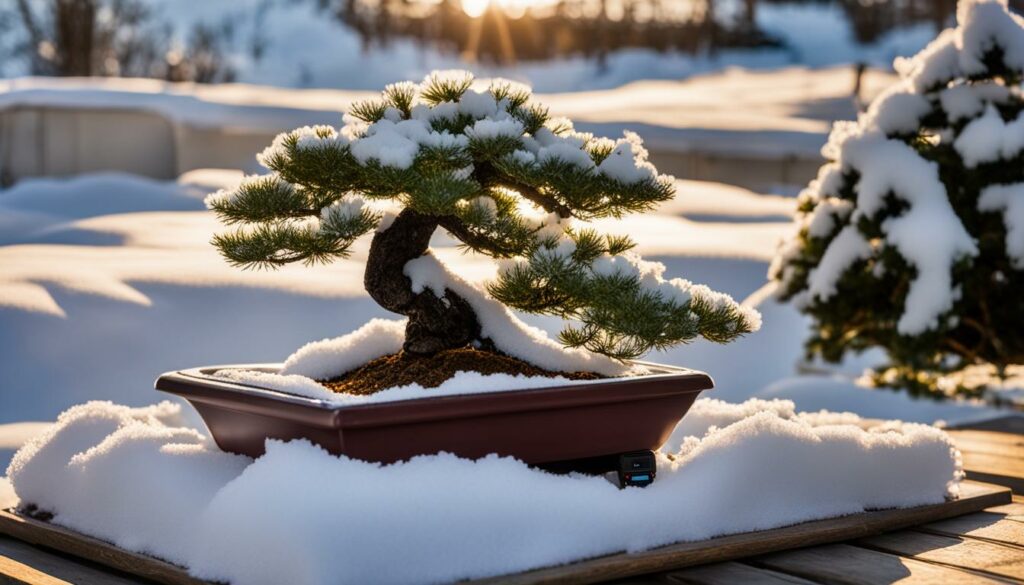
Insulating Bonsai Pots
When the cold winds howl, the roots of your bonsai are at risk. Insulation techniques come to the rescue by shielding the delicate root systems from the biting frost. Materials such as bubble wrap, horticultural fleece, or even a sturdy burlap can cocoon the pot, providing a buffer that conserves soil warmth. Additionally, consider elevating the pots from cold surfaces and opting for thermal pot stands or placing them on a layer of insulating foam.
Cold Frames and Microclimates for Bonsai
Crafting a microclimate—a smaller, regulated area within a larger environment—is a wizard’s trick in bonsai care. Cold frames, for instance, are effective structures for establishing such a controlled climate. They function as mini greenhouses, harnessing solar energy to create a snug haven against the frost care necessary for delicate species. Below is a guide to creating a simple yet effective cold frame:
| Materials | Tools | Size & Location | Additional Tips |
|---|---|---|---|
| – Transparent roofing – Insulating walls – Weather stripping |
– Drill – Saw – Screwdriver |
– Large enough to house your collection – North-facing location for stable temperature |
– Introduce a thermometer to monitor conditions – Ensure adequate ventilation to prevent mold |
Remember, every species of bonsai has unique requirements. Some may need to bask in the winter’s chill for a time, while others crave a shield from frostbite. Engaging with bona fide insulation techniques and cold protection strategies ensures that your bonsai overwintering isn’t just a period of survival but a preparation for renewal and vibrant growth come spring.
Winter Repotting: Should You Consider It?
When the temperatures dip and the chill of winter embraces your garden, certain questions concerning the care of your bonsai trees come to the forefront. One such question is whether or not to undertake repotting bonsai during this time. While some purists may frown upon the practice, others advocate for it under specific conditions. This section will explore when winter repotting might be appropriate, and the potential challenges it poses to cold protection efforts.
Traditionally, repotting is done in the spring as this is when trees begin their growth cycle. However, winterizing bonsai may in some cases also include repotting, especially if you didn’t have the chance to repot at the recommended time, and your bonsai is in dire need due to soil compaction or root-bound issues which can impair water and nutrient flow. Here are factors to consider for safe winter repotting:
- Species-specific requirements: Deciduous trees often handle winter repotting better than evergreens.
- Tree health: A tree must be healthy and free from stress to handle the repotting process.
- Environmental conditions: If you live in a region with milder winters, repotting can be a viable option.
It’s crucial to understand that repotting can be stressful for a bonsai and doing so in the colder months adds another layer of complexity due to the dormant state of the tree. Below is a table summarizing the pros and cons of winter repotting to assist you in making the best decision for your bonsai overwintering success.
| Pros of Winter Repotting | Cons of Winter Repotting |
|---|---|
| Prevents root-bound stress | Potential root damage in cold |
| Ready for spring growth | Risk of dehydration and frost |
| Milder winters allow flexibility | Limited recovery if tree is not hardy |
| Can address soil degradation issues | Requires careful timing and monitoring |
If you do choose to repot during the winter, ensure you provide adequate cold protection afterwards. This might involve placing the repotted bonsai in an area where it can slowly acclimate back to the cold, or providing additional insulation to the pot to prevent root shock.
In conclusion, while winter repotting is not typically advisable, it may be necessary under certain circumstances. However, it’s imperative you weigh the risks and benefits carefully. By making an informed decision, you can help ensure your bonsai emerges into spring as a vibrant miniature expression of the natural world.
When and How to Bring Bonsai Back Outdoors
As the chill of winter slowly diminishes, the time approaches to reintroduce your bonsai to the outdoor world. This period of transition requires careful attention to detail to ensure that your precious bonsai trees adapt without shock from the stark contrast in their environment. Winter care and foresight play a crucial role in the success of acclimating bonsai back into the fluctuating springtime temperatures.
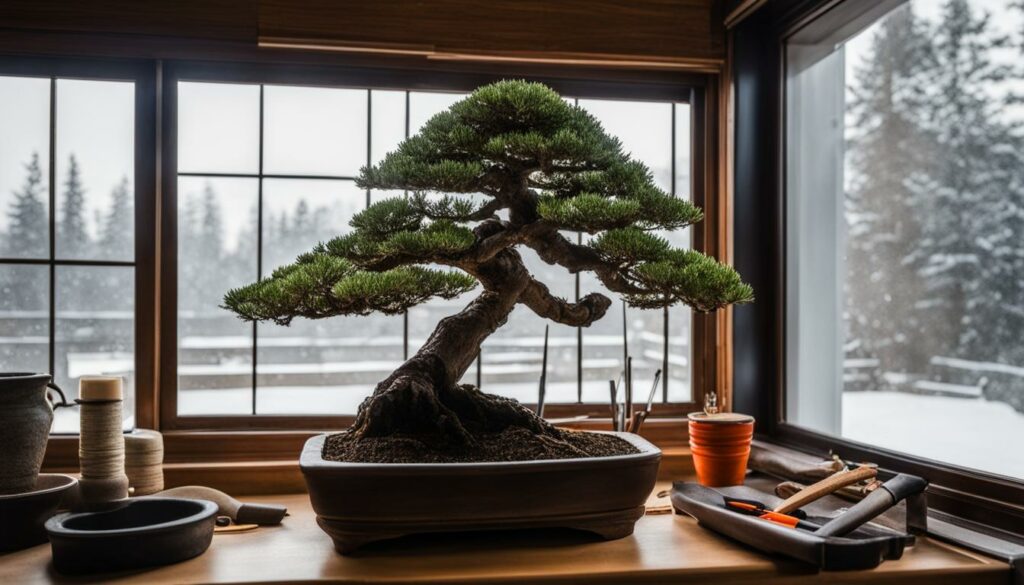
Timing is everything when it comes to moving your bonsai outdoors. You’ve spent the winter months protecting them with diligent bonsai overwintering efforts, and now, to maintain their health and beauty, a gradual reacquaintance with the natural elements is essential. But how do you know when the time is right?
Timing the Transition to Outdoor Conditions
Keep an eye on the weather forecasts; it’s not just about warmer days, but also about those potentially damaging late frosts. A good rule of thumb for beginning the transition is to wait until nighttime temperatures consistently remain above 40°F (4°C). The acclimation process should be slow and steady—a sudden move from a controlled indoor atmosphere to the unpredictable outdoors can be detrimental to your bonsai’s well-being.
Acclimating Bonsai to Springtime Temperatures
Start with a sheltered spot outdoors where your bonsai can have a few hours of morning sun and shade during the rest of the day. Increase their outdoor exposure incrementally over a couple of weeks. Monitoring and mitigating frost care during this time is critical; ensure you’re ready to move them back inside if an unexpected freeze threatens.
| Time of Day | Initial Exposure | Gradual Increase | Late Frost Preparedness |
|---|---|---|---|
| Morning | 1-2 hours of sunlight | Up to 4 hours | Have temporary protective measures ready |
| Afternoon | Shaded | Partial sun | |
| Evening | Indoors if below 40°F | Outdoors if above 40°F |
Remember, the well-being of your bonsai after winter care rests in the subtleties of transitioning. Gradual exposure and being vigilant against late frosts ensure a seamless shift from bonsai overwintering to basking in the renewing energies of spring. Patience and observation are your best tools in safeguarding the hard work you’ve invested during the dormant months. With thoughtful acclimating bonsai strategies, you’ll witness your miniature trees thriving once again in their natural habitat.
Conclusion
As the colder months approach, the stewardship you offer your bonsai becomes critical for its survival and subsequent flourishing in the spring. We’ve traversed the particulars of bonsai overwintering, recognizing that while these miniature trees exhibit robustness, they demand dedicated frost care and mindful attention to detail during their bonsai dormancy period. With each winterizing method, from choosing the proper shelter to maintaining the fine balance of moisture and temperature, your bonsai relies on your informed actions to thrive in what could be harsh conditions.
Winterizing your bonsai is more than a routine; it is a craft honed by patience and knowledge. Each step, be it repotting, pruning, or shielding from frost, intertwines to create a comprehensive care regimen customized for your bonsai’s unique needs. The diligent application of the strategies discussed will not only protect your treasured bonsai from the cold’s stark touch but also set the stage for a verdant and vibrant resurgence in the growing season to come.
As you employ the techniques covered—from establishing microclimates to acclimating your tree back to the outdoors—bear in mind the intrinsic beauty and tranquility that bonsai bring into our lives. It is this cyclical journey of preparation, protection, and eventual awakening that makes the art of bonsai deeply fulfilling. The efforts poured into winterizing your bonsai bear the promise of another year of serene beauty, a testament to the delicate harmony between nature and nurturer.
FAQ
What are the essential tips for winter care of bonsai trees?
Key tips include understanding the specific needs of your bonsai during dormancy, providing adequate cold protection, ensuring the right location for overwintering, balancing temperature and humidity, adjusting watering techniques, and protecting the tree from frost and extreme conditions.
How does dormancy impact the health and longevity of a bonsai?
Dormancy is a natural cycle in bonsai trees that conserves energy and prepares them for the spring growing season. It’s imperative for the tree’s rest and recuperation, essential for maintaining health and longevity.
Should bonsai trees be overwintered indoors or outdoors?
The decision to overwinter bonsai trees indoors or outdoors depends on the species and the local climate. Some cold-hardy species can be overwintered outdoors with proper protection, while tropical species must be kept indoors.
How do I control temperature and humidity for my bonsai in the winter?
If kept indoors, use humidifiers or trays with pebbles and water to maintain humidity, and keep bonsai away from heat sources to prevent dryness. For outdoor bonsai, ensure adequate insulation and protection from wind.
What is the proper way to water bonsai during the winter?
During winter, bonsai trees require less water due to reduced growth activity. Water only when the soil becomes slightly dry and always provide adequate drainage to prevent root rot.
Is pruning bonsai in the winter different from other seasons?
Yes, winter pruning should be more conservative, focusing on removing only dead or diseased branches. Since the tree is dormant, excessive pruning can be harmful.
How can I protect my bonsai from frost?
Protecting bonsai from frost involves providing insulation with materials like burlap or bubble wrap, using cold frames, and moving the trees to sheltered locations like garages or sheds during severe cold.
Should I fertilize my bonsai during winter?
In most cases, fertilization is not recommended during winter as the tree’s metabolism slows down. However, some slow-releasing fertilizers can be applied in late winter to prepare for spring growth.
How can I prevent and treat pests and diseases in the winter?
Keep an eye out for signs of infestation or disease, maintain proper hygiene by removing debris, and avoid overwatering. Use appropriate insecticides and fungicides if issues are detected.
What insulation techniques can I use for cold protecting my bonsai?
Insulate bonsai pots by raising them off the ground, wrapping with protective materials, and potentially using mulch. Cold frames can also create stable microclimates for outdoor trees.
Is it advisable to repot bonsai trees in the winter?
Generally, repotting is best done in the spring when trees are emerging from dormancy. However, if a tree is in distress and requires immediate attention, winter repotting might be necessary.
When is the right time to bring my bonsai back outdoors after winter, and how do I do it?
Timing depends on the species and local climate. Begin transitioning trees back outdoors when the risk of frost has passed, gradually acclimating them to outdoor conditions to avoid shock.
